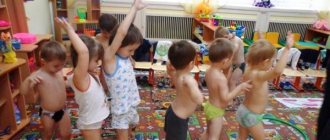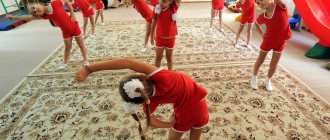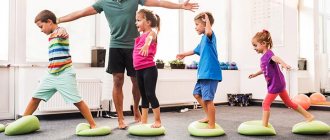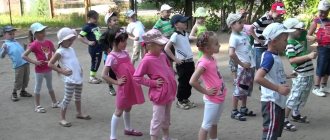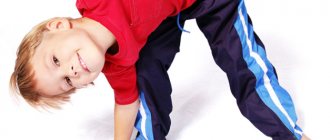Methodology for morning exercises for children of all age groups
Methodology for morning exercises for children of all age groups.
In the process of morning exercises, it is necessary to ensure the correct physical, mental and emotional stress. Physical activity increases gradually: having reached its highest value during jumping and running, it decreases towards the end of morning exercises. The motor density of morning exercises should be high, so minimal time is allocated for explaining and demonstrating exercises, distributing physical education equipment and changing lines. Physical activity increases by increasing the number of repetitions of each movement, the pace of their execution and reducing the interval between exercises. It also depends on the total duration of morning exercises: in the first junior group its duration is 4–5 minutes; in the second youngest - 5-6 minutes; on average - 6-8 minutes; in the eldest – 8–10 minutes; in preparatory school - 10-12 minutes.
Morning exercises use exercises familiar to children, so the mental load (on attention, memory) is almost always moderate. Physical exercise has a more beneficial effect on the body when it evokes a cheerful mood and positive emotions. And the teacher, correctly alternating exercises and giving sufficient load, creates interest in children in morning exercises. It is equally important to carry out the exercises emotionally, using various techniques and musical accompaniment. However, exercise and music should not overstimulate children because this can lead to fatigue and decreased appetite.
At the beginning of the year, children of the first junior group are not lined up before performing exercises: they walk and run in a flock, scattered. In the future, morning exercises in this group also begin with formation in a column, one at a time or in one line. Turns to the right, left, and around are more often used in older groups.
To perform general developmental exercises, young children are lined up in a circle, scattered; from the middle group they are usually rebuilt into a column of three or four. With this structure, it is easier for the teacher to monitor the quality of general developmental exercises performed by all children and to pay attention to correct posture.
At the beginning of morning exercises, walking in place is often given (regular, with high knees). This helps organize children and focus their attention.
To prevent flat feet, it is advisable to give different types of walking in the following combination at the beginning and at the end of morning exercises: normal walking, on toes, heels, and the edges of the feet. This combination is repeated 6–8 times.
It is useful to change your walking speed - from slow to fast, from fast to slow (with acceleration and deceleration).
It is necessary to ensure that children do not shuffle their feet or sway when walking, keep their heads straight, swing their arms rhythmically, and breathe through their nose. The teacher prevents mistakes with appropriate instructions, and if they do occur, corrects them without stopping walking.
When walking with high knees, imitation is used (“horses”, “herons”, “walking in deep snow”).
Running in morning exercises in younger groups is first carried out in a flock, scattered, and then in a column one at a time, both in place and with advancement in different directions.
Before general developmental exercises, running is performed at an average pace and alternates with walking. After performing general developmental exercises, running is carried out at a faster pace to train the cardiovascular and respiratory systems. The alternation of running and walking is repeated 2-3 times. The duration of running without a break gradually increases: for younger children it is 10–20 s, for middle age – 20–25 s, for older age – 25–30 s, for children 6 years old – 30–40 s (these norms can be changed depending on on the state of health, physical development, physical fitness of children). The teacher makes sure that indoors, on a playground with hard ground, children run on their toes, raising their knees higher.
Morning exercises include different types of jumps: jumping on one and two legs in place and moving in different directions (forward, backward, sideways, etc.); jumping over objects (sticks, hoops, cubes); For older children, the total number of jumps in morning exercises can be increased to 25–30. In younger groups, imitation (“bunnies”, “balls”) is used when jumping.
General developmental exercises for morning exercises are selected in the following sequence: first, exercises are given for the muscles of the arms and shoulder girdle, after which exercises that strengthen the muscles of the torso and legs are advisable.
At the end of the gymnastics, after running, alternating with jumping and walking, exercises can be performed for the shoulder girdle and arms, which help calm the body.
Exercises for large muscles (especially in older age) are combined with movements for the muscles of the neck, hands, fingers and feet. For example, when raising your arms up, it is recommended to simultaneously clench your hands into fists and unclench them.
The number of general developmental exercises and their dosage increase with the age of children, as physical development and physical fitness improve. For children of the first junior group, 3–4 exercises are recommended; for the second youngest – 4 and middle – 4–5; for the eldest – 5–6; for preparatory school – 6–8. In the first and second junior groups, the exercises are repeated 4–5 times; on average - 5-6 times; in the oldest – 6–8 times; in preparatory school - 8-10 times. In this case, exercises for the arms and shoulder girdle are repeated more times (8–10); and more difficult ones - for the abdominal muscles, back - 4-6 times.
Exercises can be performed at different paces, for example: first 2-3 times at a medium pace, then 3-4 times at a fast pace, then 2-3 times at a slow pace. This increases physical stress on the body, promotes the development of speed, and increases children’s interest in the activity.
General developmental exercises are performed from different starting positions of the body: standing, sitting, lying down (on the back, on the stomach). The starting positions of lying down and sitting are beneficial in that they relieve the pressure of body weight on the spine and fragile arch of the foot, and allow you to increase the tension of individual muscles. Therefore, during morning exercises, it is recommended to use chairs and gymnastic benches to perform exercises from starting positions while sitting. Exercises for the arms and shoulder girdle are performed by younger children from the starting position - narrow leg stand apart, and by older children - the main stand, closed stoic position.
Exercises for the trunk muscles at a younger age are carried out from the starting position: narrow leg stand apart, leg stand apart, and at an older age - leg stand apart, wide leg stand apart.
In leg exercises at a younger age, a narrow stance with legs apart is used, and at an older age, the main stance is used.
When conducting general developmental exercises with objects, you need to think through the order of their distribution and collection, and provide for the formation of the group so that the children do not interfere with each other.
At an older age, general developmental exercises without objects occupy a larger volume.
In younger groups, the teacher performs general developmental exercises with the children. In the middle group, he first names the exercise, briefly explains it (shows it if necessary), and then gives a command for the starting position and execution. When explaining, children's attention is fixed on the most difficult elements of the exercise. If errors do occur, instructions for correcting them are given during the exercise. Instructions should be aimed at clarifying the understanding of the elements of the exercise and facilitating their correct implementation. This is helped by combining counting with words denoting elements of the technique, or even replacing counting with specific words (for example, instead of “one”, the teacher says: “Squat down, back straight”).
The teacher must think about when he will use counting when repeating an exercise, and when he will replace it with words that clarify the idea of this element of technique. The appropriate alternation of counting, words (instructions) and other signals (moving the hand down - “crouched”, upward - “straightened up” in the “squat” exercise) helps children perform the movement more correctly and with great interest.
At an older age, children can do the exercise by name, but sometimes in the older group the teacher does the exercise together with the children. This reduces the reminder time and increases physical stress on the body. Following the teacher’s actions, children clarify their understanding of movement technique and try to correct mistakes. But such a joint exercise is only advisable if the teacher sees the whole group and can observe the actions of the children and their behavior (when bending to the sides, when squatting, etc.). Sometimes a child who does the exercises correctly is placed at the front of the group.
During morning exercises, the teacher carefully monitors each child and, if necessary, provides physical assistance to individual children, gives instructions, and encourages (especially younger children).
When performing general developmental exercises, imitation is used in all age groups. For younger children, the complexes are built in a plot form and based on one image (“birds”, “butterflies”, “watches”, “planes”, etc.). Instructions are given to children according to the selected image (for example, “the sparrows flew”). In the second younger group, children imitate different images in one complex. In the middle group, imitation is used only when performing some exercises, and in the older group - to perform individual elements of the exercise.
During morning exercises, the teacher makes sure that each exercise ends with a good straightening of the torso, which helps strengthen the muscles that support the straight position of the body, as well as strengthening the skill of correct posture. When performing exercises, the teacher reinforces the children's correct breathing skills.
Musical accompaniment during morning exercises helps children simultaneously start and finish the exercise in a timely manner, determines the tempo of individual elements of the movement, evokes positive emotions and creates a cheerful mood. Children learn to listen to music and coordinate movements with its character, perform exercises clearly, expressively, smoothly.
Features of the methodology for conducting morning exercises on the site. In spring and summer, as a rule, morning exercises are carried out with children of all age groups on the site. The teacher, depending on the weather, selects exercises and regulates physical activity: when the temperature drops, he increases it, changing the pace of performance; when the temperature rises, it decreases to avoid overheating of the body.
In late autumn and winter, morning exercises can be carried out on the site with children who are the most physically prepared and seasoned. Exercises are selected taking into account temperature, clothing and are performed at a more vigorous pace. Particular care must be taken to ensure that children do not get cold.
Features of the methodology for conducting morning exercises in a mixed group. If the children in the group differ sharply in age (from 2–3 to 6–7 years), then morning exercises are carried out separately with each subgroup.
If the age difference between children is small (for example, children 5 and 6 years old), then morning exercises can be done simultaneously with everyone. When changing lanes, older children help the younger ones complete the task. When walking, older children are given more complex tasks (for example, placing their hands to their shoulders).
General developmental exercises are selected so that they are accessible to both subgroups, and all children begin to perform them at the same time. Then younger children rest, and older children continue to perform the exercise several more times at a faster pace. When running and jumping are given, the dosage is increased for older children.
Options for morning exercises
Various forms of morning exercises are used:
– traditional form using general developmental exercises;
- playing out some plot: “On a walk”, “We went to the meadow”, “Sparrows”, etc.;
– gaming nature (from 3-4 outdoor games);
– using elements of rhythmic gymnastics, dance movements, round dances;
– recreational running (carried out on a site for 3-5 minutes with a gradual increase in distance, intensity, time);
– using an obstacle course (you can create different obstacle courses using a variety of modules);
– using the simplest exercise equipment (children’s expander, gymnastic roller, etc.) and complex exercise equipment (“Bicycle”, “Rowing”, “Treadmill”, “Trampoline”, etc.)
Used Books:
- Golitsina N.S., Bukharova E.E.
Physical education kaleidoscope for preschoolers. – M.: Publishing house “Scriptorium 2003”, 2006.
- Kartushina M.Yu.
Logorhythmics for kids: Scenarios for classes with children 3 – 4 years old. – M.: TC Sfera, 2005. – 144 p. (Development program.)
- Kartushina M.Yu.
Scenarios of recreational activities for children 3–4 years old. – M.: TC Sfera, 2007. – 96 p. – (Series “Together with children”).
- Penzulaeva L.I.
Health-improving gymnastics for preschool children (3 – 7 years old). – M.: Humanitarian Publishing Center VLADOS, 2003. – 128 p.
- Sochevanova E.A.
Complexes of morning exercises for children 3 – 4 years old: Methodological manual. – SPb.: “CHILDHOOD-PRESS”, 2005. – 48С.
- Kharchenko T.E.
Morning exercises in kindergarten. Exercises for children 3 – 5 years old. – M.: Mosaika-Sintez, 2008.
